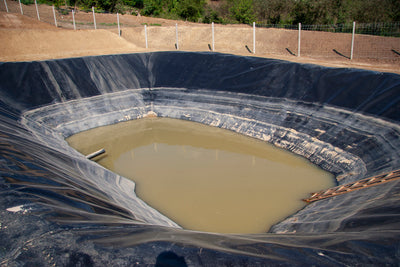Water Quality InformationWritten By Actual Experts
RSSDrinking Water Supplies Risk Contamination from Toxic Wastewater Ponds

Radium In Drinking Water: What You Need To Know

Arsenic In Drinking Water: What You Need To Know

We do everything from providing in-depth breakdowns of common contaminants to reports on city tap water quality. We’re keeping it going by writing about another common heavy metal that can contaminate drinking water: Arsenic.
How Are We Exposed To Arsenic?
Humans are exposed to inorganic arsenic mainly through contaminated drinking water. Some water sources in the United States have higher naturally occurring levels of inorganic arsenic than other regions. Levels of inorganic arsenic in soil typically range from 1-40mg/kg and the EPA recommended concentration in water supplies is less than 10µg/L. However, higher levels can occur near natural mineral deposits, mining sites, smelting industries, and regions where pesticides have been applied.
In addition, workers who use arsenic compounds for smelting, pesticide manufacturing and application, and wood preservation are at a higher risk for arsenic poisoning.
Below is a map published by the United States Geological Survey (USGS) which shows the concentration of arsenic in groundwater in the United States. It’s estimated that 2 million Americans have private wells and drink water with unsafe levels of Arsenic. If you live in one of the areas with high arsenic concentration, and get your drinking water from a private well, we highly recommend getting your water tested by a qualified laboratory.

Arsenic Toxicity
Arsenic is a toxic heavy metal several epidemiological studies have reported a strong association between arsenic exposure, cancer, and systemic diseases. In fact, arsenic exposure affects virtually all organ systems including the cardiovascular, dermatologic, nervous, hepatic, renal, gastrointestinal, and respiratory systems. The severity of the adverse health effects is related to both the chemical form of arsenic and the dosage. Evidence of carcinogenicity due to arsenic exposure is very strong, but the specific mechanism by which it causes cancer is not completely understood.
Recent studies have found that pregnant women are especially susceptible to the harmful effects of arsenic exposure. Arsenic exposure can drastically impact reproductive outcomes, affect fetal development, and can lead to long term health problems. However, the association between chronic arsenic exposure and adverse pregnancy outcomes is not widely recognized.
What Can I Do To Reduce My Exposure To Arsenic?
A growing number of people are realizing that regulatory limits are not always in line with current toxicological studies, and are taking steps to minimize exposure to heavy metals like arsenic, lead, mercury, and chromium 6 from their drinking water, even if their city is "in compliance" with EPA regulations.
Unlike lead, which leaches into water from pipes, arsenic comes from the source water itself, so flushing pipes or replacing plumbing will not reduce arsenic concentrations. Boiling water also does NOT remove arsenic. Arsenic must be removed using a water filter that is specifically designed to do so.
Whole House Filters
While some whole house filters can reduce arsenic levels to some extent, we don't recommend most whole house water filters due to their high cost and unnecessary filtration of water when it isn't consumed (such as flushing the toilet). Instead, we advocate for point-of-use water filters, which are more efficient and cost-effective for filtering water that is being consumed.
In cases where arsenic levels are very high and exceed our performance specifications, we may suggest considering a specialized arsenic removal filter at your home's point of entry to bring the levels within our operating parameters. Once this is achieved, you can use a Hydroviv filter at your point of use for further arsenic reduction.
Point Of Use Water Filters For Arsenic
The most cost-effective method of arsenic, chromium 6, and contaminants filtration is through a point of use water filter. When shopping for these systems, we encourage you to make sure that the filter actually filters arsenic (most don't). While we believe that our advanced under sink filters have unique benefits and use filtration media that effectively remove both types of inorganic arsenic, some systems that use reverse osmosis can be a good choice for people who are willing to accept the downsides. No matter what... make sure that your filter removes what you think it does!
As always, feel free to take advantage of our “help no matter what” approach to technical support! While we do make water filters that remove arsenic, our water nerds are happy to answer your questions about the effects of arsenic in water, even if you have no intention of purchasing a Hydroviv Water Filter. Reach out by dropping us an email (hello@hydroviv.com) or through the live chat on our webpage.
Other Articles We Think You'll Enjoy
5 Most Important Things To Know About Arsenic In Drinking WaterWhat Most People Don't Know About Well Water Quality
How Do I Filter Chromium 6 From My Drinking Water?
Chromium 6 In Drinking Water: What You Need To Know

Wendy Spicer, M.S. | Scientific Contributor
***Updated 10/27/2022 to include recent health studies and regulatory status.
If you have seen the movie Erin Brockovich, you are familiar with chromium 6 (also known as hexavalent chromium and chromium VI). The film tells the story of a legal clerk turned activist who uncovers that a California utility company, Pacific Gas and Electric (PG&E), was knowingly dumping chromium 6 waste and contaminating the local water supply. Brockovich’s law firm, Masry and Vititoe, represented over 600 clients in a lawsuit against PG&E which settled for $333 million dollars in 1993. Despite the success and fame of this story, chromium 6 water contamination remains largely unregulated and problematic across the United States. The Environmental Working Group estimated that in 2015, water supplies serving over 218 million Americans were contaminated with chromium 6.
What Is Chromium?
It is important to note that there are 2 very different forms of chromium that are often grouped together when reporting contaminant levels. These two different types vary based on their oxidation states, meaning that they differ in the number of electrons surrounding the atom’s nucleus. Chromium (III), or trivalent chromium is a naturally occurring element that is an essential nutrient, and is beneficial, not toxic to humans. In fact, chromium(III) plays a role in glucose, fat, and protein metabolism by increasing the effect of insulin.
However, chromium 6 is the highly-toxic form of chromium. Industrial discharge is the largest source of chromium 6 in our environment and is released into air and wastewater by metal processing facilities, tannery facilities, chromate production, stainless steel welding, ferrochrome production, and pigment production. The major way that most people are exposed to chromium 6 is through contaminated food and water.
What Are The Adverse Health Effects Of Chromium in Water?
There is strong evidence that chromium 6 is a human carcinogen. The most recent EPA draft toxicity review states "Cr(VI) is likely to be carcinogenic to humans by the oral route of exposure.”
Specifically, this study suggests that chromium 6 causes stomach cancer in humans, consistent with previous tumor results reported in rodent studies. Chromium 6 exposure is also known to cause multiorgan toxicity such as kidney damage, allergy, and asthma. This study compared the toxicity of chromium 3 to chromium 6 in kidney cells, and scientists observed toxic effects in cells treated with chromium 6 but not with chromium 3.
In addition to being a likely carcinogen, the most recent EPA draft toxicity review discusses negative health effects affecting organ systems including gastrointestinal, liver, immune, hematologic, as well as the male reproductive system. In addition, the developing fetus is considered especially susceptible because Chromium 6 was determined as a likely cause of developmental toxicity in humans.
Chromium 6 is also a known endocrine-disrupting chemical, and this study documented that environmental exposure to chromium 6 caused detrimental reproductive effects in women and negative health effects in infants in California. In fact, the scientists reported that women with occupational chromium 6 exposure experienced infertility, pregnancy loss, spontaneous abortion, and stillbirth.
Breathing high levels of chromium 6 can cause irritation to the lining of the nose, and nose ulcers. Lung and respiratory cancers are more common in industrial workers (where it is more likely to be inhaled) while gastrointestinal tumors are more common in humans and animals exposed to chromium 6 in drinking water. Accidental or intentional ingestion of extremely high doses of chromium 6 compounds can cause acute respiratory, cardiovascular, gastrointestinal, hematological, hepatic, renal, and neurological distress which may result in death.
Is Chromium 6 Regulated?
Chromium 6 in drinking water is not currently regulated by any State or at the Federal Level. However, the California Water Resources Control Board’s Drinking Water Program is the first in the nation to unveil a proposal to set a “maximum contaminant level” (MCL) of 10 parts per billion, or ppb, in water. The board is also proposing to set the “detection limit,” which would trigger reporting, at 0.05 ppb. The current Public Health Goal in California (the level below which there is no expected health issues) for Chromium-6 is 0.02 ppb.
Other Articles We Think You’ll Enjoy:
What You Need To Know About Chromium 6How To Filter Chromium 6 From Water
How To Tell If Your Home Has Lead Pipes





